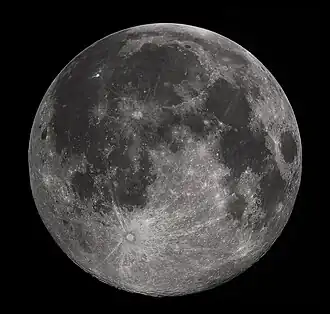Portal:Solar System/Selected article/6

The Moon is Earth's only natural satellite. It orbits around Earth at an average distance of 384,399 kilometres (238,854 mi), about 30 times Earth's diameter. Its orbital period (lunar month) and its rotation period (lunar day) are synchronized at 29.5 days by the pull of Earth's gravity. This makes the Moon tidally locked to Earth, always facing it with the same side. The Moon's gravitational pull produces tidal forces on Earth which are the main driver of Earth's tides.
In geophysical terms, the Moon is a planetary-mass object or satellite planet. Its mass is 1.2% that of the Earth, and its diameter is 3,474 km (2,159 mi), roughly one-quarter of Earth's (about as wide as the contiguous United States). Within the Solar System, it is the largest and most massive satellite in relation to its parent planet. It is the fifth-largest and fifth-most massive moon overall, and is larger and more massive than all known dwarf planets. Its surface gravity is about one-sixth of Earth's, about half that of Mars, and the second-highest among all moons in the Solar System after Jupiter's moon Io. The body of the Moon is differentiated and terrestrial, with only a minuscule hydrosphere, atmosphere, and magnetic field. The lunar surface is covered in lunar dust and marked by mountains, impact craters, their ejecta, ray-like streaks, rilles and, mostly on the near side of the Moon, by dark maria ('seas'), which are plains of cooled lava. These maria are believed to have formed when molten lava flowed into ancient impact basins. It is thought that the Moon was formed 4.51 billion years ago, not long after Earth's formation, out of the debris from a giant impact between Earth and a hypothesized Mars-sized body named Theia. (Full article...)